With Christophe Galtier’s departure for PSG, a new coach will have the opportunity to take on the OGC Nice project.
Les Aiglons have chosen former manager Lucien Favre this time and given him the chance to take over at the Allianz Riviera again.
The Swiss manager was in charge of Nice for two years between 2016 and 2018.
During that period, the club qualified for the UEFA Champions League and competed for the Ligue 1 title in 2017 before he left to join Borussia Dortmund in 2018.
Although his reputation wasn’t enhanced during his spell in charge of Dortmund, his appointment will surely be welcomed with positivity in the south of France, given his achievements and attacking style of play produced the first time around.
However, the modern-day OGC Nice he is taking over is an entirely different proposition from the one he left.
INEOS purchased the club in 2019—the summer after he left—and has since spent €164.43m on improving its playing squad.
Given the likelihood that Favre will be backed in the transfer market, it will be interesting to see what he can achieve with the club this time around.
This article will be a tactical analysis focusing on the tactics adopted by OGC Nice throughout Lucien Favre’s first spell in charge of the club.
We will analyze the tactical principles in their play and focus on the key features of a Favre side that, under his watch, put Nice in contention for the Ligue 1 title and Champions League football.
Lucien Favre Tactical Style
Well-organised, emphasising ball retention and switching between a high and low tempo will always be the best description of Lucien Favre’s tactical style in our book.
Due to his tactical understanding of the game, he has earned the nickname “The Brain” throughout his career.
His tactical approach shows this; he isn’t ingrained into playing just one system.
Favre is a very adaptable manager and will often change the team’s formation to meet the requirements for that particular period or game.
Lucien Favre Formations : OGC Nice 2016-17
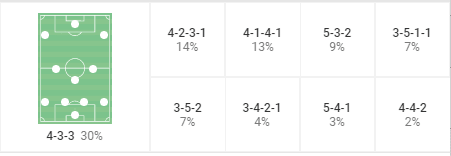
Lucien Favre Formations : OGC Nice 2017-18
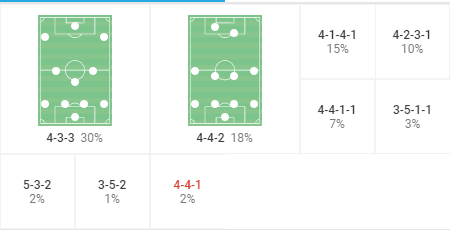
You can see from the data above how many different formations he used previously at OGC Nice.
The 4-3-3 formation was and will likely remain his go-to shape, as it provides the most flexibility due to its many variations.
This suits the Swiss coach’s in-game adaptability, given the positional rotation and freedom of movement he allows.
Favre’s 4-3-3 formation provides each ball barrier with at least two options to pass to during possession.
Throughout his time at Borussia Mönchengladbach, Nice, and Borussia Dortmund, Lucien Favre’s teams have shown they can play dynamic, quick-transition, and attack-minded football, but controlling through possession will always remain a key tactic within his style.
Lucien Favre Attacking Style Of Play
When Favre took over OGC Nice in 2016, he immediately implemented his possession-based system.
The playing squad at the time was perfectly suited to controlling and winning possession, with players like Jean Michaël Seri and Wylan Cyprien playing important roles in central midfield.
The possession approach Favre focused on, saw Nice move fluidly around the pitch as a team as they enjoyed building through each third of the pitch.
This saw the team move laterally and vertically towards the ball in both halves of the pitch.
The onus was on making sure the play was always supported, providing the team with the best opportunity to retain possession.
In both the 2016/17 and 2017/18 seasons, OGC Nice finished second to PSG for the highest amount of possession kept in Ligue 1 with an average of 56.9% and 56.3%.
Lucien Favre’s attacking tactics clearly intended for Nice to remain patient when holding the ball and focus on moving the opposition with their play.
Although they finished second for keeping the highest amount of possession, they only finished in 11th and seventh place for the number of shots they had on goal per game, achieving 11.5 and 12.8 in each season.
Now that Favre is back at the Allianz Riviera, Nice will once again focus on building up very patiently from the goalkeeper, through the centre backs and then through the middle and attacking thirds.
Lucien Favre Tactics At OGC Nice: Build-Up Play From The Goalkeeper
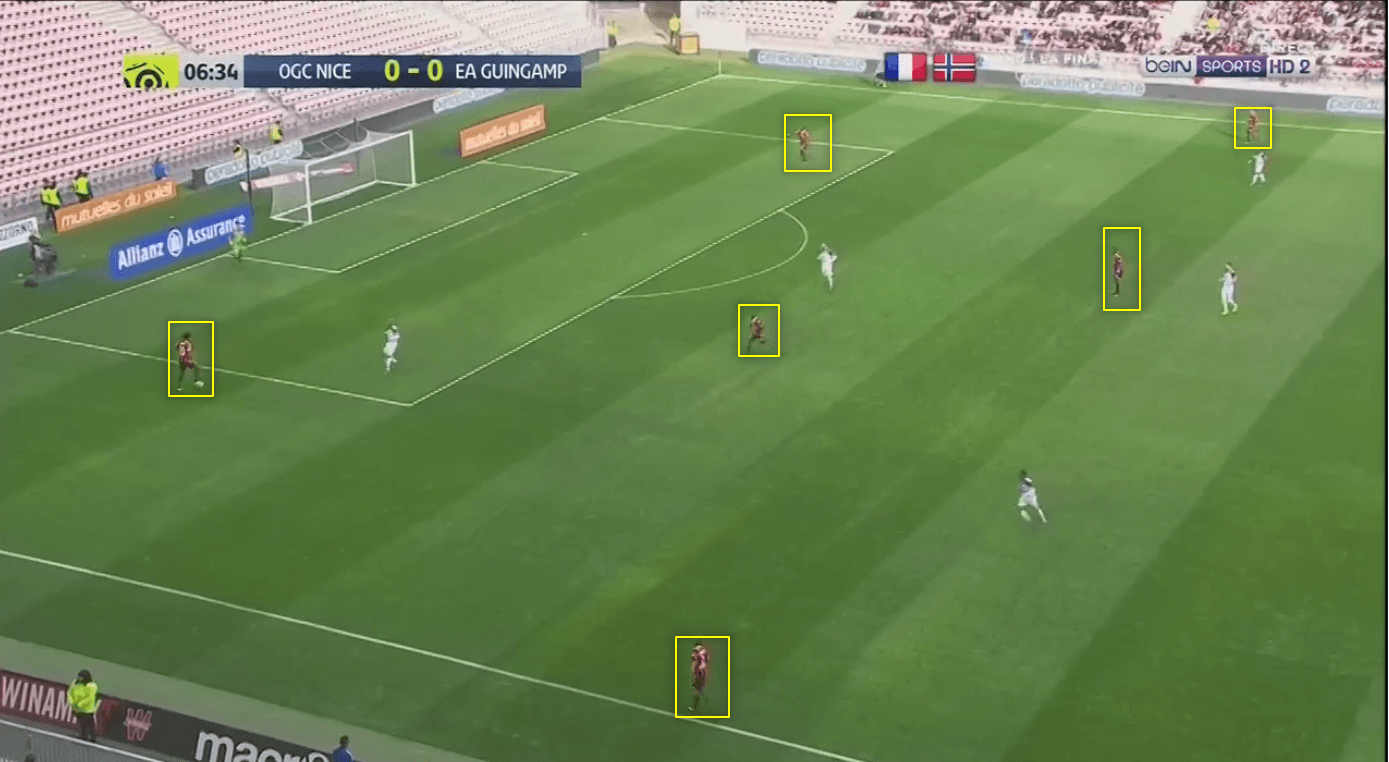
Their build-up play features six players, as shown above.
The centre-backs split, with two midfielders dropping to form a double pivot and the full-backs pushing higher.
The players dropping deeper who become involved in the build-up are used as decoys to invite the opposition to press higher and push more players towards the ball.
This is a tactical ploy of Favre’s possession game as they move their opponents from any defensive shape they hold.
Lucien Favre Tactics At OGC Nice: Build-up Play From Defensive To Middle Third
Nice’s attacking shape as they build from the defensive third through to the middle third is a 2-4-1-3.
One of the central midfielders sits further forward and acts as a spare man, ready to support either the fullbacks or the double pivot depending on whether Nice builds through the centre or the wings.
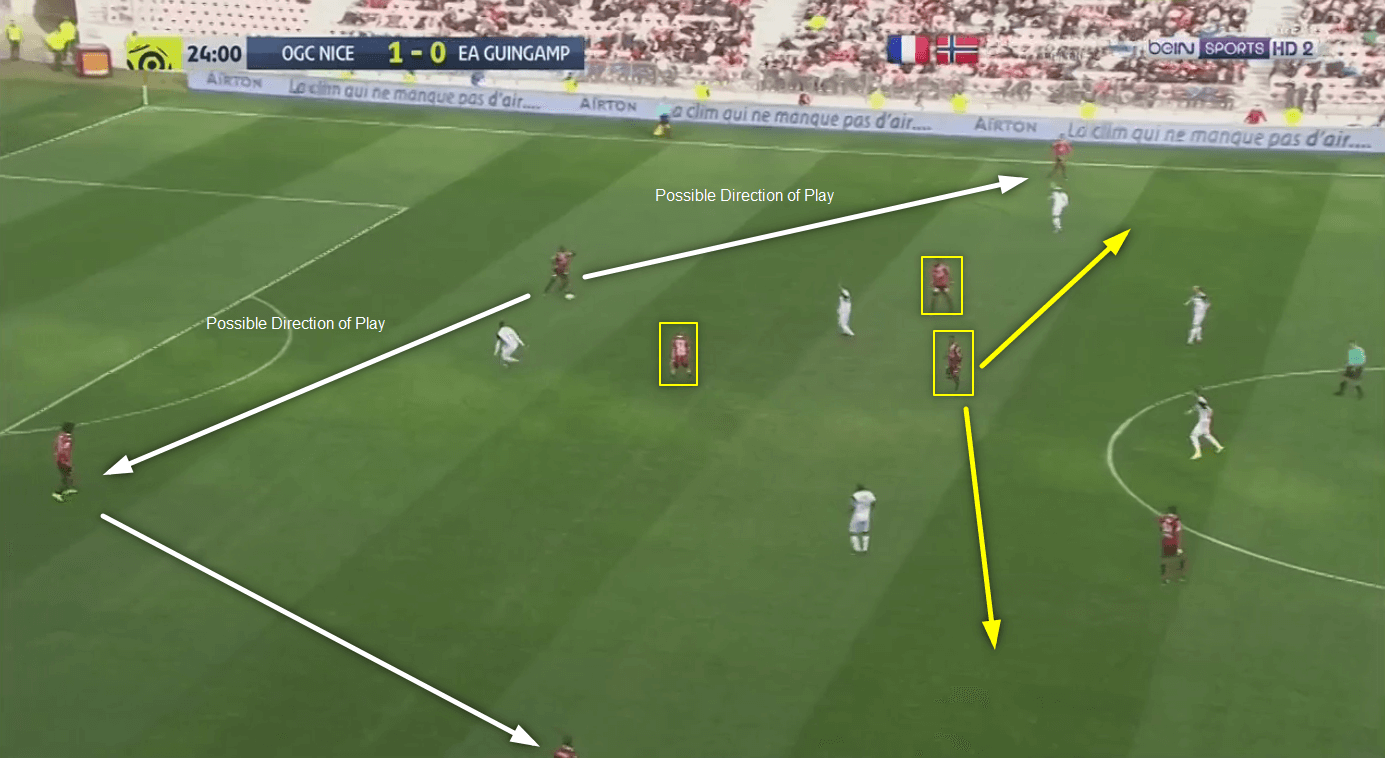
As the team plays through the middle third and looks to enter the other team’s half of the pitch, Favre will want his players to have full coverage across the pitch laterally.
He will want one player in each wide channel, one player in each of the half spaces and one player occupying the pitch centrally.
The best way to achieve this is for the team to transition into an attacking shape that forms a five- or six-man attacking line, like a 3-1-6, 2-3-5, or 3-2-5 formation.
Below, you can see how Nice is progressing with a 2-3-5 shape, which gives them a five-man attacking line with options across the pitch.
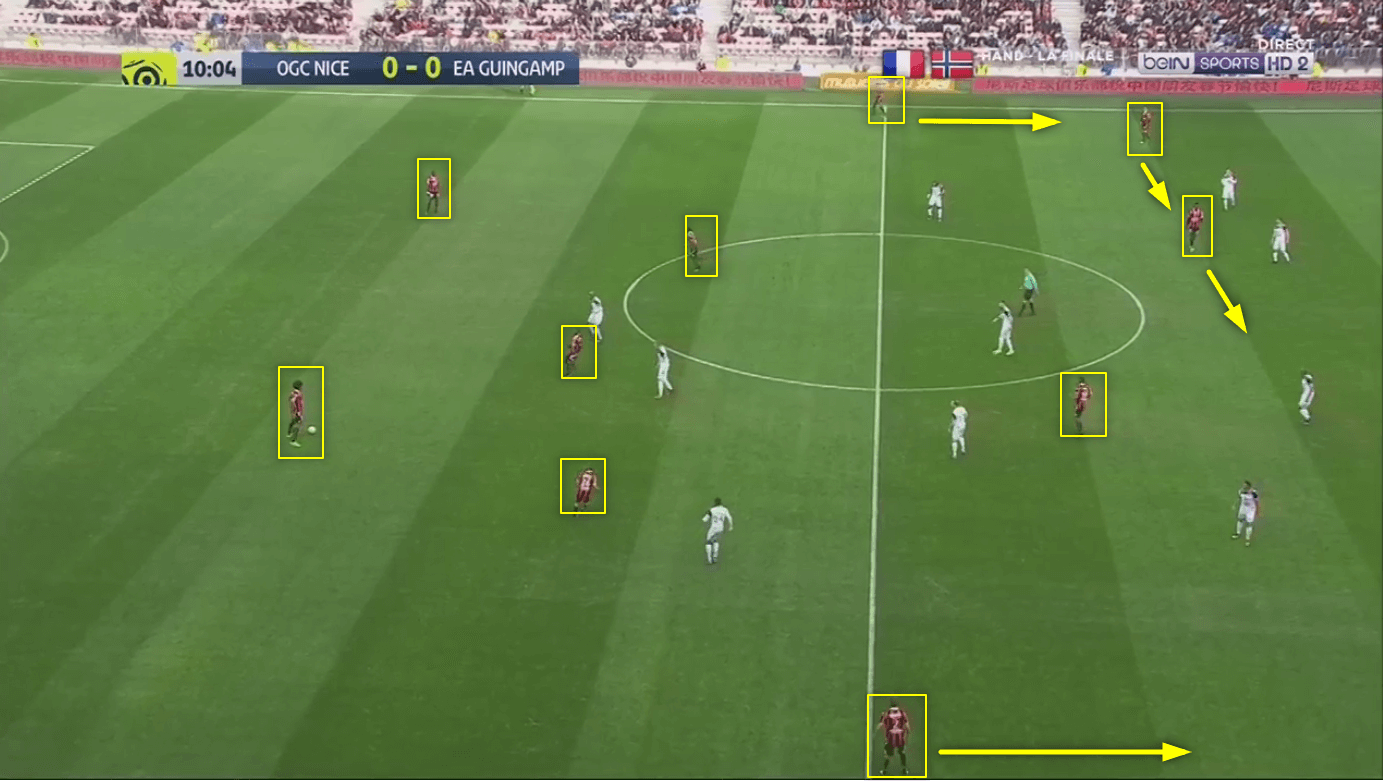
Lucien Favre Tactics At OGC Nice: Entering The Final Third
This attacking play continues as they enter the attacking third of the pitch.
Favre will want Nice to attack the opposition similarly to the way they did in his first reign — by overwhelming their defence in numbers and disrupting the defensive line with movement and the positions they assume.
The following two examples show Nice attacking centrally and from out wide through the pitch.
Guingamp’s defence was forced to remain narrow because of the positions that Nice’s forwards have taken up. Each forward occupies the space between each defender within the defensive line, allowing the fullbacks to push up and overload the wide areas.
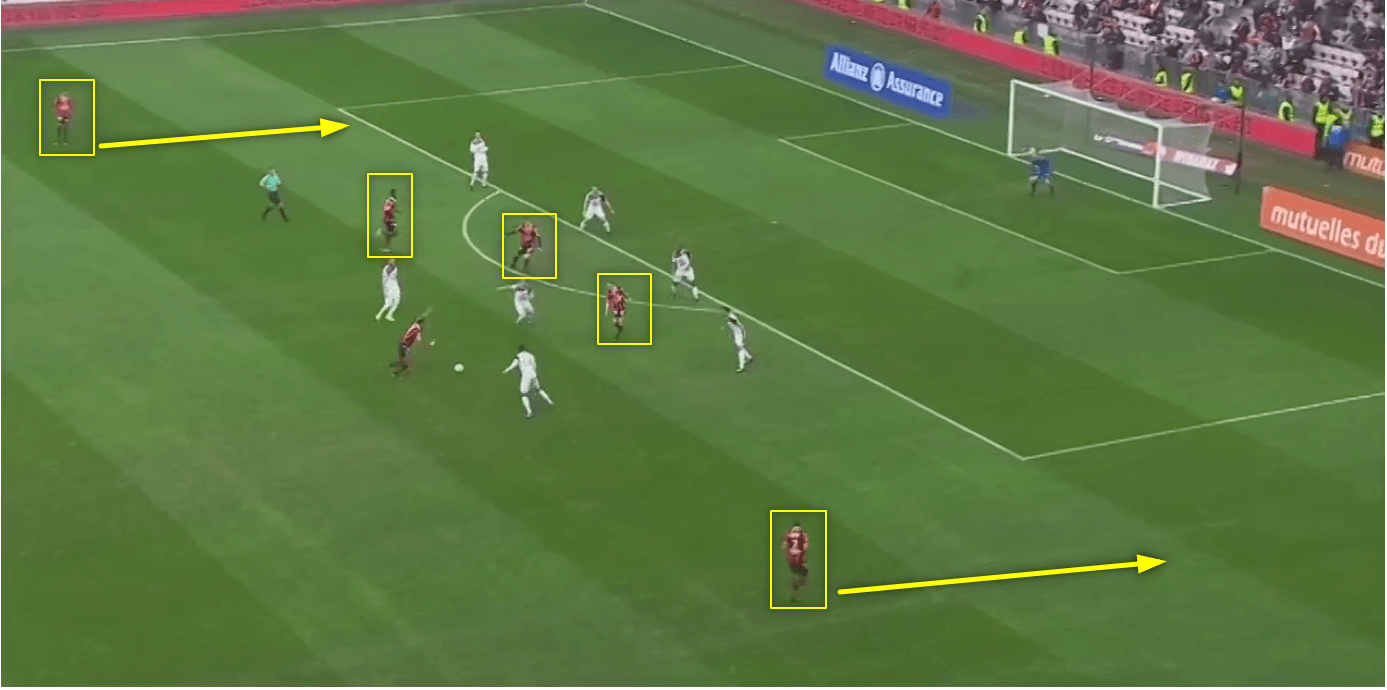
This time the full-back on the right-hand side, Arnaud Souquet, has made an underlapping run whilst Alassane Pléa remains out wide and makes the cross.
Pléa moving out wide and Souquet running inside attracts Guingamp’s defensive line towards the ball, creating gaps right across the penalty area.
You can see how disjointed the defensive line has become, and Nice’s left-back, Dalbert Henrique, has become a spare man attacking from the left-hand side.
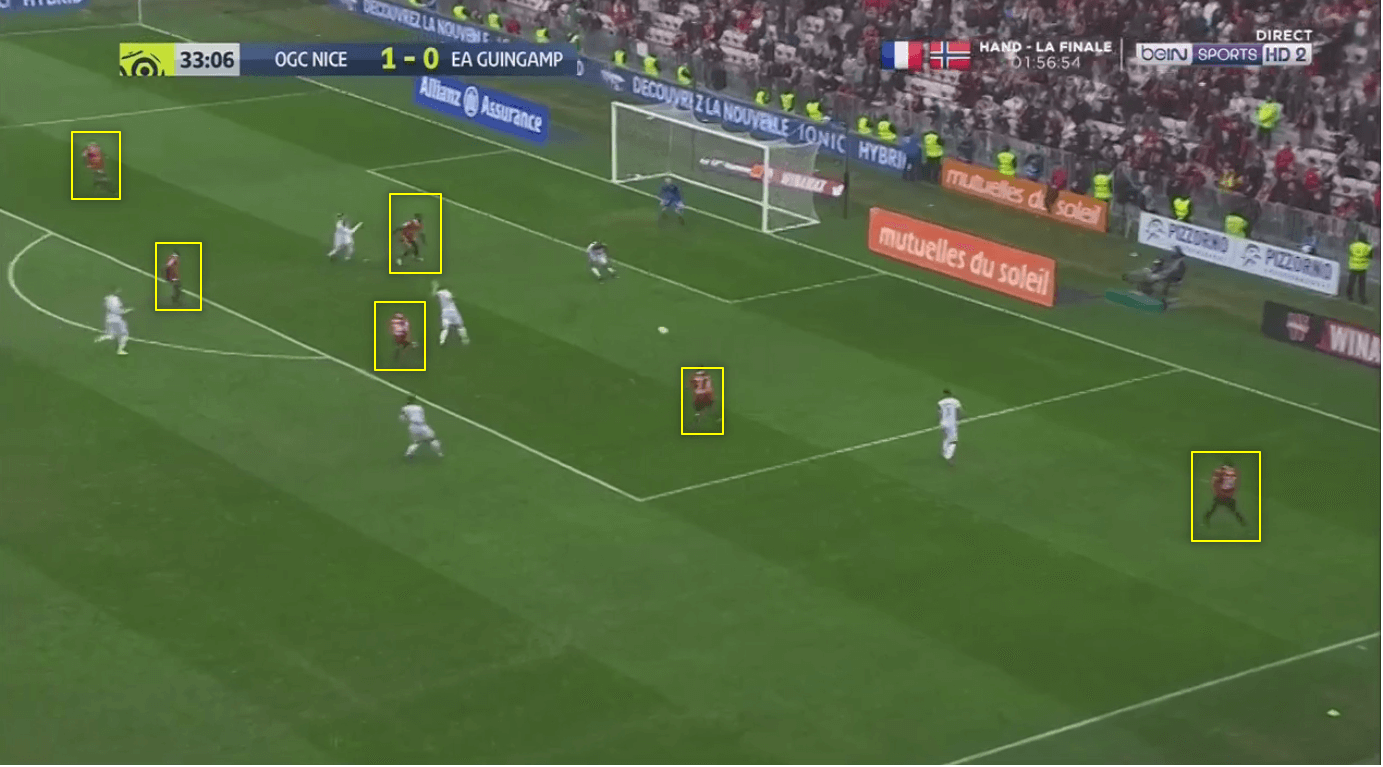
Lucien Favre Defensive Style Of Play
The team’s attacking shape provided them with a good structure for winning the ball back when they are out of possession, and Favre will likely look for similar defensive traits to those he instilled at the club during his last spell.
They kept a well-organised defensive shape with a man-orientated pressing system.
Although Favre instructed Nice to win the ball back as quickly as possible and as high up the pitch as possible, it wasn’t necessarily triggered by pressing instantly and aggressively.
The focus was to stay compact, cut off the passing lanes, and then direct the play to the wide areas.
As the play is moved to either side, Nice would then shuffle across as a team and compress the space, forcing the opposition into a mistake.
Lucien Favre Tactics At OGC Nice: Defensive Formations
The defensive shape the team transitioned to would vary depending on the formation being used in that match.
The 4-3-3 formation would see them defend in a 4-1-4-1 shape, while the 4-2-3-1 formation would see them implement a 4-4-2 defensive shape.
When they used a 3-5-2 formation, they would switch to a 5-4-1 shape that would become a 5-2-3 depending on the areas the opposition held the ball.
The image below shows Nice players positioning themselves as their opposition plays out through their defence.
Nice will hold a 4-1-4-1 defensive shape high up the pitch but will not immediately or aggressively press the ball carrier.
Lucien Favre Tactics At OGC Nice: Defensive Pressing
Each player looks to protect their area of the pitch.
Lucien Favre´s team will allow the centre-back time to assess his options, and once that first pass is made or he carries the ball further, Nice’s centre-forward will start closing down.
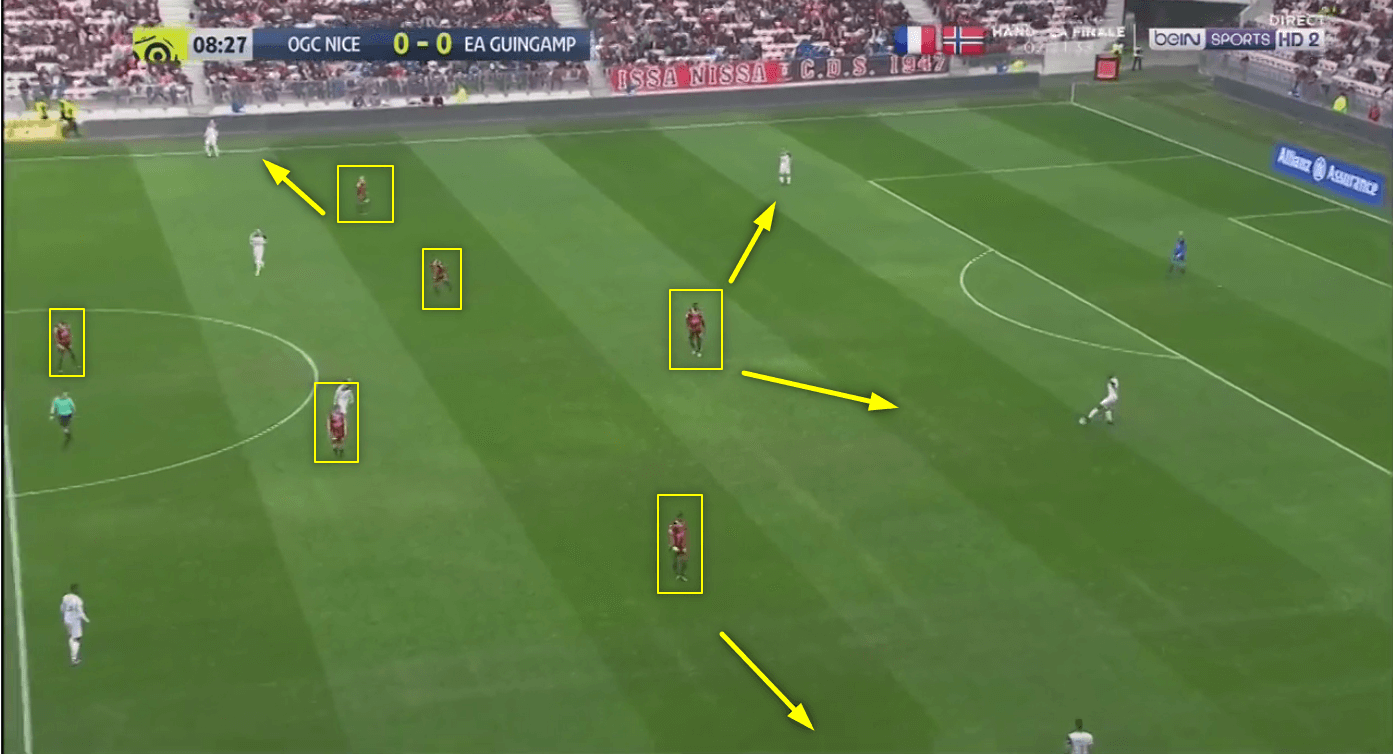
The centre-forwards trigger the press by directing the play to the sides and then limiting any passing options.
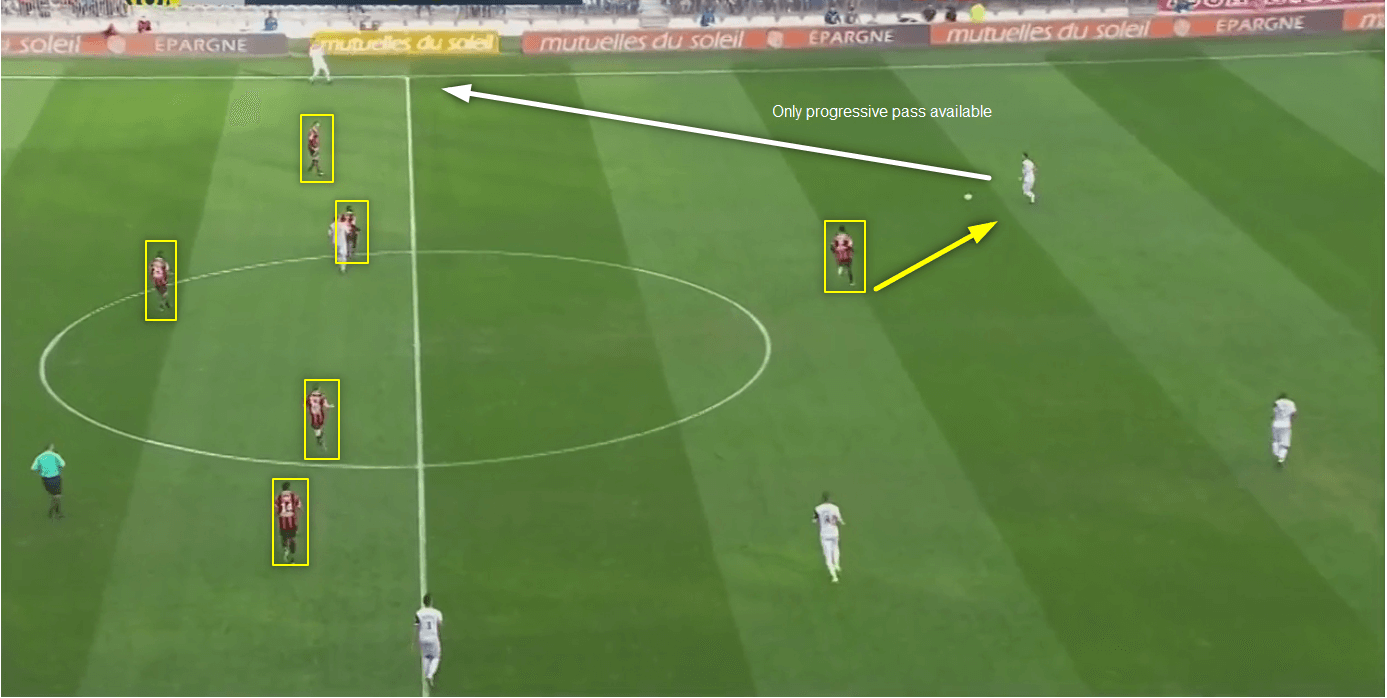
When the play is forced outside to either wide man, Nice then look to overload that area and press to win the ball back.
The full-back and the winger on the relevant side will each look to close the ball down with intensity, and then a central midfielder will join to complete the overload and increase the chance of gaining possession.
Lucien Favre wants his teams to move together as a unit when defending.
So, when the play is moved out wide, as the image below shows, Nice will move across the pitch laterally and try to congest the space.
When this happens, the ball’s far side is left open, which could leave them vulnerable to the play being switched directly to the other flank.

Lucien Favre’s Favorite Defensive Formation At OGC Nice
Lucien Favre’s favoured formation is the 4-3-3.
The analysis shows the formation’s benefits and why it suits OGC Nice’s tactics.
However, the defensive aspect of the 4-3-3 is just as fundamental to Favre’s tactics.
The 4-3-3 offers you flexibility and the opportunity to switch your defensive shape.
This was something that Favre took full advantage of at Nice the last time around.
Below, you can see how the team played in a 4-3-3 system and defended in a 4-1-4-1 against Guingamp.
However, at this point, they have switched to defend in 4-4-2 as one of the centre midfielders pushes forward to join the centre forward in the attacking line; in this case, it was Jean Michaël Seri.
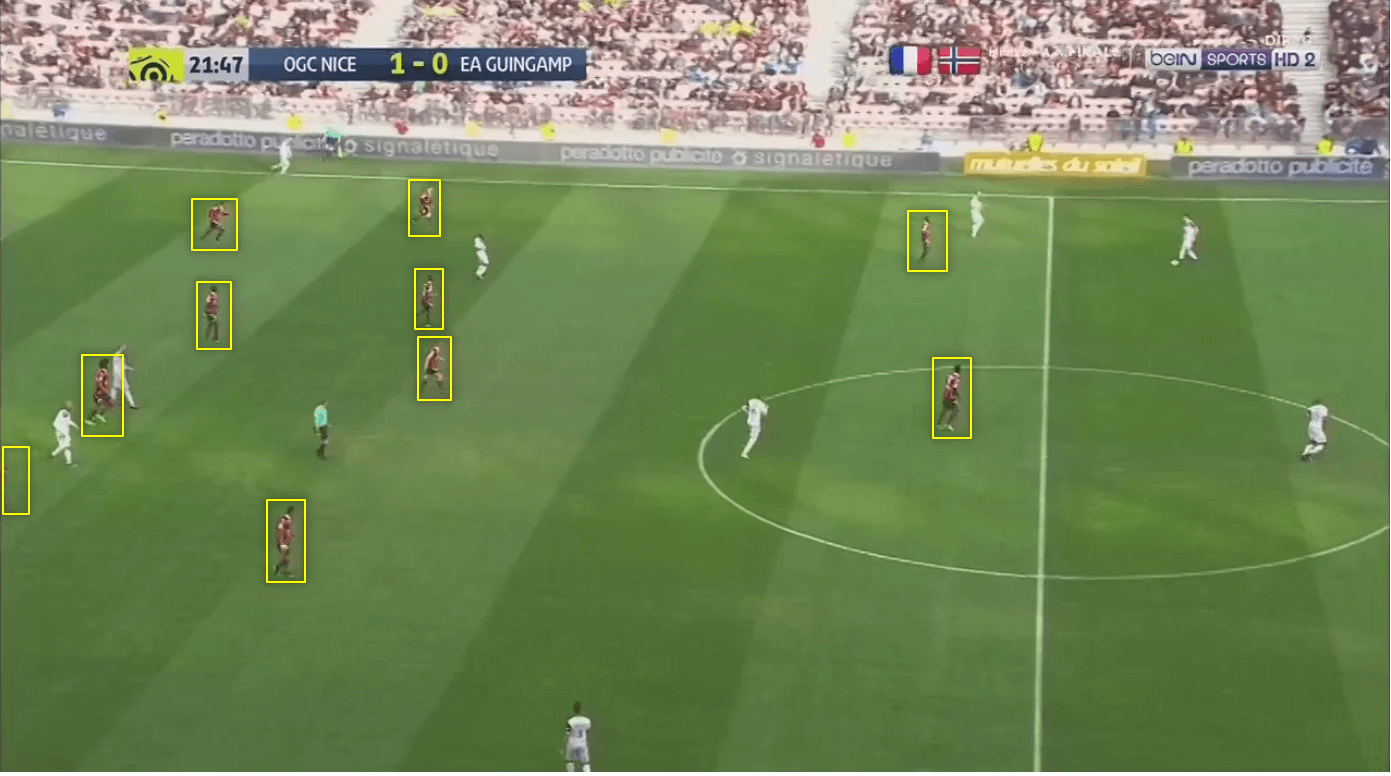
Seri was pivotal to Lucien Favre’s tactics in the first spell, in the same way that Mario Lemina and Pablo Rosario could prove to be during this next term in charge.
Conclusion
Lucien Favre’s replacement for Christophe Galtier could prove to be the perfect fit for OGC Nice.
The Swissman shaped last season’s tactics around a solid 4-4-2 formation, which some felt was unsuitable for the current crop of players.
However, if Favre and his coaching staff can hold on to some of the defensive principles within their approach and then build on that structure with his more expansive and fluid tactical system, then players such as Khéphren Thuram and Amine Gouiri, who at times looked lost within Galtiers’ tactics, will almost certainly benefit from the freedom within Favre’s tactics.
This analysis shows some of the main aspects of Lucien Favre’s tactical approach at Nice during his first spell as manager.
We have looked at the key tactics surrounding the attacking and defensive structure that the Swiss tactician implements within his philosophy, and we imagine most of them will be recognisable in his next Nice team, too.





Comments